Cans for bulk products: types, brands, selection and operation

Modern housewives, in whose families it is customary to eat at home, pay close attention to proper nutrition. But for homemade food to be really healthy and wholesome, it must be prepared from quality products. For this, food stocks must be properly stored. WITHloose products - flour, granulated sugar, pasta, various types of cereals - make up a significant part of the family's food reserves.

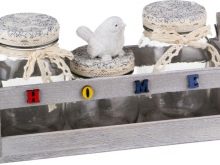

Peculiarities
In almost every modern kitchen, to comply with storage conditions, there are special containers for storing bulk products. Now you can easily buy food in any supermarket, so there is no need to store it at home in the amount of strategic stocks. Out-of-date stocks, even when properly stored by the end of the recommended storage period, change the taste not for the better. But this does not mean at all that you have to run to the store every time before preparing food. In the kitchen, each housewife always has a supply of food, depending on the composition of the family.

It is best to store bulk products in a closed, sealed container.
These can be jars with a lid, containers, boxes of different sizes, shapes, colors, made of various materials. In ordinary bags, bugs and moths often start in food, dampness and mold appear. Storage in special containers allows you to preserve the initial properties of the products during the entire recommended shelf life.It is necessary to put the filled containers in a kitchen cabinet, where it is dark and dry, since sunlight, water vapor and various smells from cooking do not contribute to the safety of food.

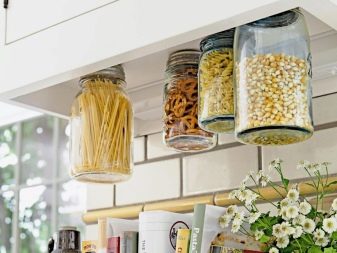
You can store supplies on open kitchen shelves, but only in opaque sealed containers so that light and moisture do not affect them.
Bulk products are not only cereals and flour. Tea, coffee, sugar, spices and seasonings also need to be stored properly. Almost all of them have a specific smell. When storing them, it is important to ensure tightness so that odors do not spread to other products.

Shapes and sizes
In retail chains, you can find many varieties of utensils for storing food. These are mini-containers for 0.1 liters, and medium-sized cans for 0.5-1.5 liters, and large containers from 1.6 liters and above. Small jars are suitable for storing spices, small volumes are preferred by people with little food consumption, large containers are bought for a large family.
In shape, cans are square, rectangular, oval, cylindrical.

The height and width are varied so that you can choose the dishes according to the dimensions of the shelves of a particular kitchen cabinet.
There are narrow and high containers, there are low and wide ones. If the height of the shelf allows, then with narrow tall containers the space in the cabinet is used more rationally. The same can be said for rectangular containers. They fit more tightly on the shelf, with virtually no voids between them. At the same height, they fit more cereals than cylindrical ones.
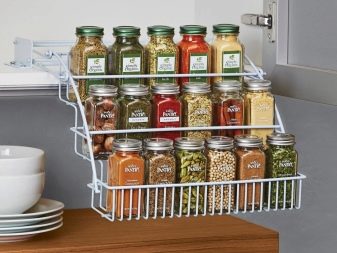

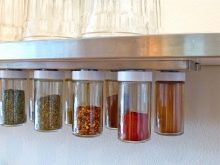


Materials and colors
In the manufacture of utensils for storing bulk products at home, manufacturers use plastic, glass, ceramics, metal, wood. The cost of the dishes mainly depends on the material.
Glass
Beautiful glass jars are the most popular among others. They do not have their own smell and do not absorb strangers, are safe, easy to clean, in harmony with any kitchen design, and are sufficiently airtight. Both transparent and colored glass are used. Almost all bulk products can be stored in glass containers (flour, sugar, cereals, pasta, etc.). Not suitable for storing dried fruits due to lack of ventilation. A significant drawback is the fragility of the material, it is required to handle such dishes with extreme care so as not to break. Currently, glassware is produced from impact-resistant glass, but such products are more expensive.



Plastic
Various shapes and sizes of plastic containers, colorful design, wide range of colors, affordable cost, lightness and compactness allow you to choose a worthy option for any kitchen. For convenience, many models have dispensers in the lid to gently pour the food.
However, such boxes are inferior in durability to other counterparts; over time, they can lose transparency, change color and crack.
New high-quality containers have a subtle smell that quickly disappears with use, but inexpensive products smell more harsh and take longer to fade. Polypropylene products have proven themselves best.


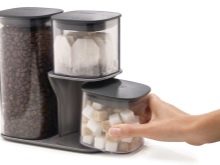
Metal
Cereals were stored in metal tin boxes even in the days of our grandmothers. But simple iron boxes quickly rusted inside and out under the influence of the kitchen environment. It became unsafe to store food in such jars. Nowadays, stylish sets of metal cans are made from stainless steel or food grade aluminum.
They perfectly preserve the contents, do not transmit light. Equipped with tight covers, air does not penetrate inside.
Can be placed on open shelves in the kitchen. It is a lightweight, strong, durable material. It should be noted that metal cans made from regular steel can impart a characteristic metallic taste to food during storage.



Ceramics
Ceramic containers are made of environmentally friendly raw materials, odorless, easy to clean. The products are beautifully decorated, decorated with painting or monochromatic. The shape and size are different. Leaking covers. Suitable for storing dried fruits, dried herbs, salt.
There are models with a silicone gasket to ensure a snug fit of the lid. The fragility and weight of the products require careful handling.
In opaque ceramic dishes, the contents are not visible, therefore, the image of the product that is planned to be stored is often applied to the cans. If there is no picture, stickers with a picture and an inscription are applied.



Wood
Wooden tableware is a natural timeless classic, always in fashion and highly valued for its naturalness. These are not cheap items. But only spices, tea, coffee, dry herbs, bay leaves, dried fruits, salt can be stored in them. Only one type of bulk product must be used constantly. The wood firmly absorbs the smell of the stored product, which is difficult to eliminate for several years. If you pour something else into the vacated container, then the product will most likely acquire the previous smell. It is recommended to use beautiful wooden utensils for decorative purposes to decorate the interior of the kitchen, and not for storing food.


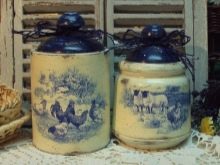
Advantages and disadvantages
Improper storage leads to product deterioration and disposal, as they become hazardous to health. Storing food supplies in special sealed containers allows you to save them from damage, prevents the penetration of insects, preserves taste and useful properties, adds comfort and convenience to the cooking process.
In addition to their direct use, containers, with a thoughtful choice of shape, color and material, complement the interior and optimize the useful space in the kitchen.

But still, even such a simple kitchen accessory has its drawbacks: fragility and heaviness of glass and ceramic vessels, instability to deformation of plastic products, insufficient tightness, absorption of odors and moisture from wooden boxes, rapid rusting of metal containers made of simple steel or tin.
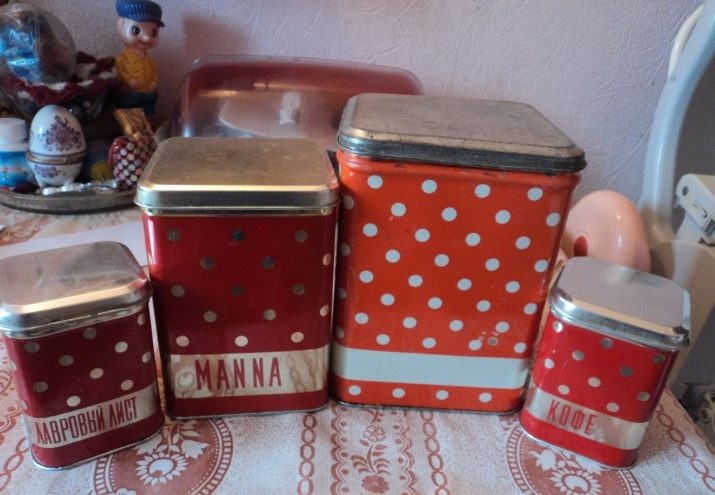
How to choose
When choosing containers for storing bulk products it is recommended to consider the following factors:
- the safety of the material of manufacture is the main selection criterion;
- take into account the composition of the family when choosing the volume;
- weight of products (light ones are more convenient, massive ones are more difficult to get from the shelf);
- the tightness of the container (check in the store);
- the stability of the applied pattern (the paint should not leave marks on the skin of the hands);
- plastic boxes should be of a uniform color, no cracks or chips, no strong smell;
- the height of the containers should be as close as possible to the height of the shelves in the cabinets so that you do not have to put the cans on top of each other - this is inconvenient;
- it is preferable to choose rectangular or square containers for efficient use of shelf space;
- you should not buy too cheap models of dubious quality, since these accessories are supposed to be used for more than one year, and low-quality goods quickly lose their presentable appearance and functional properties.

When choosing, special attention should be paid to the covers. They are of 3 types:
- threaded screw caps, metal or plastic - are sealed, convenient, but wear out over time;
- hinged lids with a latch lock - easy to open and close, allow you to instantly transform a container from a sealed to a ventilated one;
- adjoining lids are not airtight; usually, jars made of wood and ceramics are closed with such lids.
You can select the required number of cans separately, or you can purchase a ready-made set of containers.

Manufacturers overview
Among the well-known manufacturers of kitchen utensils and accessories are the following.
- Fissman manufactures numerous types of kitchenware, including kitchen accessories, made only from environmentally friendly materials without cadmium and lead. Before being released for mass sale, the dishes undergo serious testing. Light aesthetic design in light colors, branded stores, the ability to order via the Internet, brand recognition and the availability of a guarantee attract buyers. Of the minuses, it should be noted the extremely conventional designation of the manufacturer, the instability of consumer reviews, there are cases of discrepancy between price and quality.

- French brand Luminarc famous for glass tableware made of impact-resistant glass - transparent, frosted or colored. The assortment also includes the highest quality porcelain products. The unique "Quality Laboratory" controls not only finished products, but also the stages of production. Luminarc sealed glass containers with a vacuum button can be used to store both bulk and liquid products. Luminarc cookware is not cheap, but the unique properties of this product make it a real pleasure to use it.

- Valiant brand products (China) began to enter the Russian market in 2005. The extensive assortment consists of several categories, one of which is kitchen utensils. Storage jars are available in various sizes, have reasonable prices and a beautiful modern design.

- IDEA (M-plastic) specializes in the production of plastic products for the home (Russia). The company was founded in 1997. The assortment consists of more than 450 items of modern functional household products. Plastic containers of the IDEA brand are made from high quality raw materials. The striking design of a predominantly red and yellow color scheme and original markings make them stand out on store shelves. Affordable prices, high quality, recognizability of the assortment pleased many consumers.
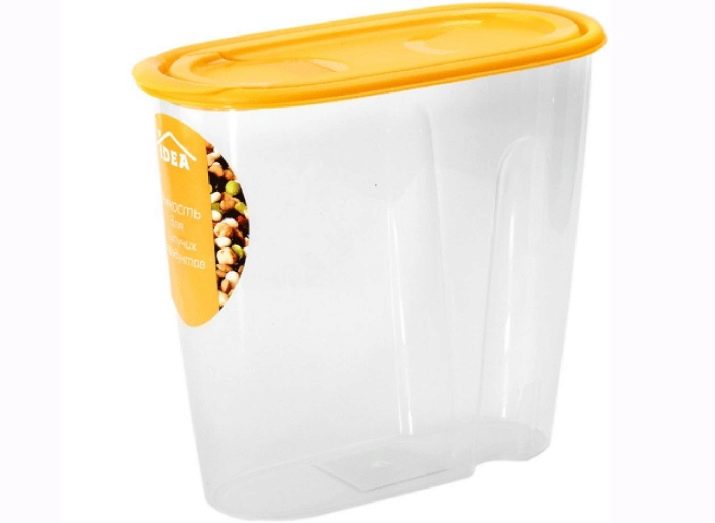
Terms of use and care
After purchase, the dishes must be thoroughly rinsed and dried. If there are no images on the containers, you can stick special stickers with inscriptions. Before you empty the storage products from the bags, you need to carefully consider whether there are lumps, mold, insect larvae. Of course, in production, effective measures are taken to prevent insect contamination of products, but unpleasant moments are still possible.
Ideal storage conditions are room temperature + 19–20 degrees and humidity not higher than 70%.

In the kitchen, such conditions are unlikely to be able to withstand, but inside the cabinets it is dark, dry and still cooler than in the room, so a closed cabinet is the best option for placing cans of bulk products.
You should not add cereal to a jar where the cereal from the previous purchase has not ended, so that a stale residue does not form at the bottom. Containers should not be placed near a hob or gas stove, where moisture evaporates during cooking and the temperature rises. It is advisable to put jars with spices and containers with cereals in separate cabinets so that the products are not saturated with the smell of spices.
It is unacceptable to store containers with bulk products next to household chemicals.

At least twice a year, you should try to conduct an audit in the kitchen: check the contents of all jars by pouring it into a suitable bowl one by one. Products with an expired shelf life should be thrown away without regret, and in order to do this as rarely as possible, you do not need to buy unnecessary products for future use, it is better to replenish stocks as needed. After the revision, all dishes must be thoroughly rinsed with baking soda and dried well, then refilled with fresh food and stored.
An overview of cans for storing bulk products, see below.








